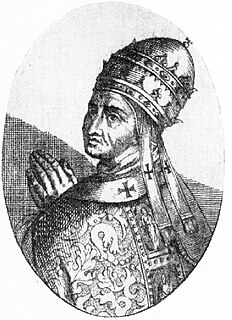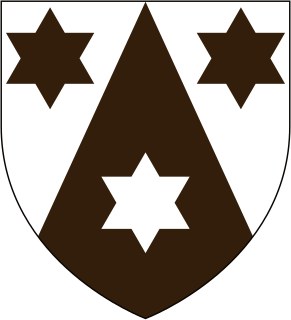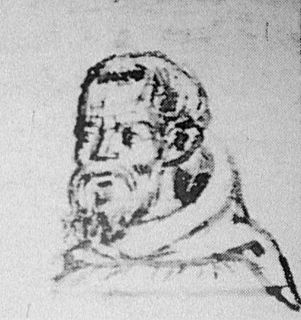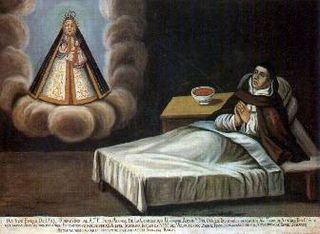Related Research Articles

Pope Benedict XI, born Nicola Boccasini, was Pope from 22 October 1303 to his death on 7 July 1304. He was also a member of the Order of Preachers.

The Carmelites, formally known as the Order of the Brothers of the Blessed Virgin Mary of Mount Carmel or sometimes simply as Carmel by synecdoche, is a Roman Catholic mendicant religious order for men founded, probably in the 12th century, on Mount Carmel in Palestine in the Crusader States, hence the name Carmelites. However, historical records about its origin remain very uncertain. Berthold of Calabria has traditionally been associated with the founding of the order, but few clear records of early Carmelite history have survived.

Pope Nicholas IV, born Girolamo Masci, Pope from 22 February 1288 to his death in 1292. He was the first Franciscan to be elected pope.

The Franciscans are a group of related mendicant religious orders within the Catholic Church, founded in 1209 by Saint Francis of Assisi. These orders include the Order of Friars Minor, the Order of Saint Clare, and the Third Order of Saint Francis. They adhere to the teachings and spiritual disciplines of the founder and of his main associates and followers, such as Clare of Assisi, Anthony of Padua, and Elizabeth of Hungary, among many others.
The Fraticelli or Spiritual Franciscans were extreme proponents of the rule of Saint Francis of Assisi, especially with regard to poverty, and regarded the wealth of the Church as scandalous, and that of individual churchmen as invalidating their status. They thus claimed that everyone else in the Church were damned and deprived of powers and were declared heretical in 1296 by Boniface VIII.

Angelo da Clareno, also known as Angelo Clareno, was the founder and leader of one of the groups of Fraticelli in the early 14th century.

Hethum II, also known by several other romanizations, was king of the Armenian Kingdom of Cilicia, ruling from 1289 to 1293, 1295 to 1296 and 1299 to 1303, while Armenia was a subject state of the Mongol Empire. He abdicated twice in order to take vows in the Franciscan order, while still remaining the power behind the throne as "Grand Baron of Armenia" and later as Regent for his nephew. He was the son of Leo II of Armenia and Kyranna de Lampron, and was part of the Hethumid dynasty, being the grandson of Hethum I, who had originally submitted Cilicia to the Mongols in 1247. He was assassinated with his nephew and successor Leo III by the Mongol general Bilarghu, who himself was later executed for this by the Mongol Ilkhan ruler Öljaitü.
Apostolic poverty is a Christian doctrine professed in the thirteenth century by the newly formed religious orders, known as the mendicant orders, in direct response to calls for reform in the Roman Catholic Church. In this, these orders attempted to live their lives without ownership of lands or accumulation of money, following the precepts given to the seventy disciples in the Gospel of Luke (10:1-24), and succeeding to varying degrees. The ascetic Pope Paschal II's solution of the Investiture Controversy in his radical Concordat of 1111 with the Emperor, repudiated by the cardinals, was that the ecclesiastics of Germany should surrender to the imperial crown their fiefs and secular offices. Paschal proved to be the last of the Gregorianist popes.

Saint John of Capestrano was a Franciscan friar and Catholic priest from the Italian town of Capestrano, Abruzzo. Famous as a preacher, theologian, and inquisitor, he earned himself the nickname 'the Soldier Saint' when in 1456 at age 70 he led a crusade against the invading Ottoman Empire at the siege of Belgrade with the Hungarian military commander John Hunyadi.

The Servite Order is one of the five original Catholic mendicant orders. Its objectives are the sanctification of its members, preaching the Gospel, and the propagation of devotion to the Mother of God, with special reference to her sorrows. The members of the Order use O.S.M. as their post-nominal letters. The male members are known as Servite Friars or Servants of Mary.
William of Alnwick was a Franciscan friar and theologian, and bishop of Giovinazzo, who took his name from Alnwick in Northumberland.

Isabella, also Isabel was queen regnant of Armenian Cilicia from 1219 until her death.
The term "Third Order" signifies, in general, lay members of religious orders, who do not necessarily live in community and yet can claim to wear the habit and participate in the good works of some great order. Roman Catholicism, Anglicanism, and Lutheranism all recognize Third Orders. They were a twelfth century adaptation of the medieval monastic confraternities.

The Order of Friars Minor Conventual, commonly known as the Conventual Franciscans, or Minorites, is a branch of the Catholic Order of Friars Minor, founded by Francis of Assisi in 1209.

Fra Jacopone da Todi, O.F.M. was an Italian Franciscan friar from Umbria in the 13th century. He wrote several laude in the local vernacular. He was an early pioneer in Italian theatre, being one of the earliest scholars who dramatised Gospel subjects.
The Third Order Regular of St. Francis of Penance is a mendicant order rooted in the Third Order of St. Francis which was founded in 1447.
Raymond de Gaufredi, sometimes anglicized as Raymond Godefroy, was Minister General of the Francican Order from 1289 to 1295.

Hayton of Corycus was a medieval Armenian nobleman, monk and historiographer.
Thomas of Tolentino was a medieval Franciscan missionary who was martyred with his three companions in Thane, India, for "blaspheming" Muhammad. His relics were removed to Quanzhou, China, and Tolentino, Italy, by Odoric of Pordenone. He is now venerated as a saint by the Roman Catholic Church, with his feast day on April 9.
Angelo of Tolentino was a 13th-century Franciscan missionary.
References
- ↑ Boas, Adrian (2015). The Crusader World. Routledge. p. 250. ISBN 978-1-317-40832-1 . Retrieved 30 December 2019.
- ↑ Angelo Clareno, Liber chronicarum, ed. 1999 V, pp. 308 f.
- 1 2 di Adriano, Gattucci (2007). "MARCO da Montelupone". Dizionario Biografico degli Italiani (in Italian). 69. Retrieved 30 December 2019.